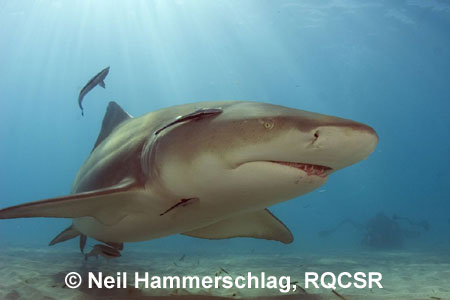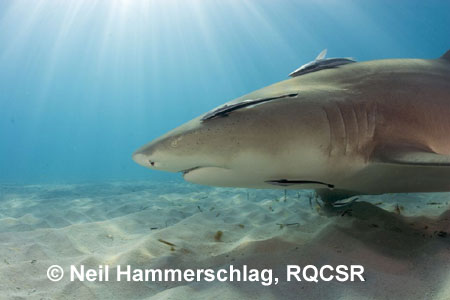Estuaries: Where the Land Meets the Sea
Lemon Shark
Named for its distinctive, yellowish-brown coloration rather than its sour disposition, the Lemon Shark (Negaprion brevirostris) is among the best-studied of sharks.
Just the Facts:
Size:
Reproduction:
Diet:
Habitat: Intertidal, Estuaries, Sandy Plains, Coral Reefs Depth: Intertidal to 300 ft (90 m) Distribution: Tropical Eastern Pacific, Western North Atlantic, Caribbean, Amazonian, West African |
Thanks to extensive, on-going studies of this species, we probably know more about the life history of the Lemon Shark than any other large, tropical shark. Part of the reason for this blissful state of knowledge is the fact that the entire life cycle of Lemon Sharks can be studied in the wild off Bimini, Bahamas — a mere 60 miles (100 kilometres) east of Miami, Florida. Bimini thus provides an exceptional and convenient natural laboratory for shark researchers, enabling them to resolve details of the Lemon Shark’s mysterious ways in unprecedented detail.
Lemon Sharks begin their independent lives in a very special kind of tropical estuary known as the mangrove swamp. Mangroves are a botanical hodge-podge of unrelated flowering plants united by a remarkable tolerance for waters with widely fluctuating salinities. These warm, oxygen-poor waters are often so rich in decomposing leaves and other organic material that they are stained the color of weak tea. These tinted, biologically productive waters swarm with myriad crabs, shrimps, worms, and small fishes. Mangrove swamps thus represent a well-stocked larder for young Lemon Sharks. The mangrove prop-roots also offer safe haven for newborns of this species, the sprawling woody fingers physically barring most large, would-be predators. The mangrove swamps of North Bimini lagoon thus provide an ideal Lemon Shark nursery, a food-rich, safe place in which to be born.
Active and alert from the moment they squirm tail-first from their mother’s vent, Lemon Shark pups feed on virtually anything they can catch. Experiments indicate that each Lemon Shark pup consumes between 1.5 to 2.1% of its body weight each day. Under such rich feeding conditions, the newborn sharks grow rapidly — those that successfully avoid predators and other perils during their first year increase their size by 3 to 4 inches (8 to 10 centimetres) and more than 1.5 pounds (0.7 kilograms).
Lemon Shark pups are well adapted to their oxygen-poor, murky mangrove habitat. Their blood has an unusually high affinity for oxygen, becoming saturated at a partial pressure twice as low that of most fishes. In addition, young Lemon Sharks can expand their gill pouches to expose an extra 20% of their gill membranes to enhance oxygen-uptake. To help them hunt a complex visual landscape of impenetrable shadows interspersed with shimmering brightness, young Lemon Sharks’ pupils are able to dilate and contract very rapidly — giving them a decided advantage over fleeing teleost fishes, in which the pupils cannot adjust for ambient light. Migratory pigment cells cover the shiny reflective layer behind the Lemon Shark’s retina, reducing glare like built-in sunglasses. Sharp, color eyesight is enhanced in young Lemon Sharks by having peak sensitivity shifted toward the yellow-green part of the spectrum — the very light wavelengths that dominate and penetrate farthest in this tannin-stained environment.

Lemon Shark pups at Bimini seem to display some manner of habitat selection. They preferentially remain in the warm, shallow waters over rocky or sandy bottoms within the lagoon, apparently avoiding the cooler, deeper water offshore. For the first three years of their lives, Lemon Sharks remain within well-defined home ranges that are relatively small, each patrolling an area less than a tenth of a square mile (quarter of a square kilometre) — or about the combined area of 11 American football fields. Although their home ranges often adjoin, there is no indication of territorial defense or overt aggression among neighboring individuals. Young Lemon Sharks thus get along peacefully as they hunt the shallows for food to fuel their growth.
As young Lemon Sharks grow, their home range expands to about half a square mile (just over a square kilometre) — or about one-third the area of New York’s Central Park. The diet of the growing Lemon Sharks expands, too, incorporating larger teleosts, stingrays, and even small sharks. By the time they are about 5 years old, Lemon Sharks are about 5 feet (1.5 metre) long and have little to fear from predators. In response, their peregrinations from the nursery lagoon become bolder, the sharks venturing ever farther out into the Atlantic for short periods. At an age of seven years and a length of 6 feet (1.8 metres), Lemon Sharks exploit a home range of some 3.5 square miles (9 square kilometres) — nearly three times the area of Central Park. Eventually, by the time they reach sexual maturity at an age of 12 or 13 years and a length of 7 feet (2.1 metres), each Lemon Shark’s home range has expanded to as much as 36 square miles (93 square kilometres) — or about the size of Florence, Italy.
Telemetry studies in the Bahamas have shown that mature Lemon Sharks are strongly site-attached and display very predictable patterns of movement. At Bimini, Lemon Sharks tracked during the day are consistently located eastward of their night-time haunts. Tracking studies indicate that the sharks move westward over the reef flats at sunset and back eastward at sunrise, apparently using the sun as an orientation cue. Lemon Sharks fitted with speed sensors demonstrated increased swimming activity at dawn and dusk, with point-to-point speeds up to twice as fast as those recorded at day or night.

Direct observations of Lemon Sharks at Bimini suggest that this species is highly social. Groups of two or more individuals are often seen traveling together. Clusters of up to 12 Lemon Sharks have been observed milling about and apparently interacting with one another. Four or more Lemon Sharks have been observed circling a small area and up to nine individuals have been observed following one another, lined up nose-to-tail. In addition to hanging out with others of their own species, Lemon Sharks at Bimini frequently travel with large schools of a type of jack known as a Blue Runner (Caranx crysos). It has been suggested that sharks make use of the expanded sensory abilities of Blue Runner schools and the jacks derive protection from association with their fearsome companions.
Fearsome as they are, Lemon Sharks barely replace themselves. Between birth and maturity, a female of this species increases its mass 150-fold. This feat requires about 15 years to achieve. Gestation lasts 12 months and recovering energy stores after pregnancy requires yet another year. Lemon Shark litter sizes are small, averaging about 10 pups. Therefore, if a female Lemon Shark lives 25 years, she may bear only five litters or about 50 pups. On average, only 20 of those pups will survive their first year. Perhaps only one or two of these will survive to maturity and manage to secure enough energy to breed successfully, delivering the next generation of Lemon Shark pups into the relative safety of the mangrove swamp nursery.
The silty, smelly waters of the mangrove swamp are thus vitally important to Lemon Shark survival. Yet throughout the Gulf of Mexico, Bahamas, and Caribbean region, mangrove swamps are being bulldozed over at an unprecedented rate to make way for shore-front hotels and shops. Time will tell whether the Lemon Shark will survive this relentless loss of its nursery areas to a species driven more by economics than ecology.

